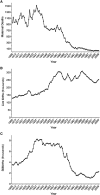Impact of reproductive laws on maternal mortality: the chilean natural experiment
- PMID: 24844146
- PMCID: PMC6027001
- DOI: 10.1179/0024363913Z.00000000022
Impact of reproductive laws on maternal mortality: the chilean natural experiment
Abstract
Improving maternal health and decreasing morbidity and mortality due to induced abortion are key endeavors in developing countries. One of the most controversial subjects surrounding interventions to improve maternal health is the effect of abortion laws. Chile offers a natural laboratory to perform an investigation on the determinants influencing maternal health in a large parallel time-series of maternal deaths, analyzing health and socioeconomic indicators, and legislative policies including abortion banning in 1989. Interestingly, abortion restriction in Chile was not associated with an increase in overall maternal mortality or with abortion deaths and total number of abortions. Contrary to the notion proposing a negative impact of restrictive abortion laws on maternal health, the abortion mortality ratio did not increase after the abortion ban in Chile. Rather, it decreased over 96 percent, from 10.8 to 0.39 per 100,000 live births. Thus, the Chilean natural experiment provides for the first time, strong evidence supporting the hypothesis that legalization of abortion is unnecessary to improve maternal health in Latin America.
Keywords: Abortion; Fertility paradox; Maternal health; Maternal mortality; Women education.
Figures





Similar articles
-
Abortion policy and women's health in developing countries.Int J Health Serv. 1990;20(2):297-314. doi: 10.2190/V08N-UE7N-TNBH-RA4P. Int J Health Serv. 1990. PMID: 2332264
-
Illegal abortion in Latin America.IPPF Med Bull. 1982 Aug;16(4):1-2. IPPF Med Bull. 1982. PMID: 12264354
-
[Chilean history of infant and maternal mortality, 1940 -1985].Perspect Int Planif Fam. 1987;(Spec No):24-8. Perspect Int Planif Fam. 1987. PMID: 12269048 Spanish.
-
Reproductive health policy saga: Restrictive abortion laws in low- and middle-income countries (LMICs), unnecessary cause of maternal mortality.Health Care Women Int. 2024;45(1):5-23. doi: 10.1080/07399332.2021.1994971. Epub 2021 Nov 2. Health Care Women Int. 2024. PMID: 34726567 Review.
-
Abortion and fertility regulation.Lancet. 1996 Jun 15;347(9016):1663-8. doi: 10.1016/s0140-6736(96)91491-9. Lancet. 1996. PMID: 8642962 Review.
Cited by
-
Abortion laws reform may reduce maternal mortality: an ecological study in 162 countries.BMC Womens Health. 2019 Jan 5;19(1):1. doi: 10.1186/s12905-018-0705-y. BMC Womens Health. 2019. PMID: 30611257 Free PMC article.
-
Abortion legislation, maternal healthcare, fertility, female literacy, sanitation, violence against women and maternal deaths: a natural experiment in 32 Mexican states.BMJ Open. 2015 Feb 23;5(2):e006013. doi: 10.1136/bmjopen-2014-006013. BMJ Open. 2015. PMID: 25712817 Free PMC article.
References
-
- Grimes D.A., Benson J., Singh S., Romero M., Ganatra B., Okonofua F.E., Shah I.H. 2006. Unsafe abortion: the preventable pandemic. Lancet 368: 1908–19 - PubMed
-
- Huneeus C., Paz Lanas M. 2002. Political science and history: Eduardo Cruz-Coke and the welfare state in Chile, 1937–38. Historia Santiago 35: 151–86. - PubMed
-
- Instituto Nacional de Estadística (INE). 2011. Estadísticas Vitales, Informe Anual 2009. Instituto Nacional de Estadística. http://www.ine.cl/canales/chile_estadistico/demografia_y_vitales/estadis....
-
- Koch E., Aracena P., Bravo M., Gatica S., Stecher J.F., Valenzuela S., Ahlers I. 2012. a. Methodological flaws on abortion estimates for Latin America: Authors’ reply to Singh and Bankole. Ginecologia y obstetricia de Mexico 80(11): 740–7. - PubMed
LinkOut - more resources
Full Text Sources
Other Literature Sources
